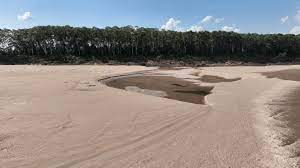
The Amazon River, the world’s largest river by discharge volume, is experiencing a significant drop in water levels due to an extended period of reduced rainfall. This unusual event is causing serious disruptions to river navigation, which is vital for transportation, trade, and daily life in the Amazon region.
See Here:
Causes of the Decline in Water Levels
The primary cause of the declining water levels in the Amazon River is an extended dry season, with significantly less rainfall than usual. The Amazon Basin, which usually experiences a wet and dry season, relies heavily on consistent rainfall to maintain its water levels. However, this year, meteorologists have reported a marked decrease in precipitation, which has led to lower-than-average river levels.
Climate change is believed to be a contributing factor, with shifting weather patterns disrupting traditional rainfall cycles. Deforestation in the Amazon rainforest also plays a role, as the loss of trees reduces the region’s ability to generate moisture through evapotranspiration, further exacerbating the dry conditions.
Impact on Navigation and Local Communities
The falling water levels are severely affecting river navigation, a critical mode of transportation in the Amazon region, where road infrastructure is limited. The river serves as a lifeline for many communities, enabling the transport of goods, people, and resources across vast distances.
With the current drop in water levels, larger vessels are struggling to navigate the shallow waters, leading to delays and increased transportation costs. In some areas, boats have become stranded, and river traffic has been significantly reduced, disrupting trade and access to essential supplies.
Local communities, many of whom rely on the river for their livelihoods, are feeling the impact. Fishing, a key source of food and income, has been disrupted as fish populations decline due to changing water conditions. Additionally, reduced access to transportation is making it difficult for these communities to receive necessary goods and services, further exacerbating the challenges they face.
Environmental and Ecological Consequences
The decline in water levels is also having profound environmental and ecological effects. The Amazon River and its surrounding rainforest are home to an incredibly diverse array of plant and animal species, many of which are adapted to specific water conditions.
As water levels drop, aquatic habitats are shrinking, putting pressure on fish and other aquatic species. Reduced river flow is also affecting the broader ecosystem, with impacts on the rainforest, which relies on the river’s moisture to sustain its unique biodiversity.
The drying of the river can also lead to an increase in forest fires, as drier conditions make the surrounding rainforest more vulnerable to burning. This not only threatens wildlife and plant species but also contributes to further deforestation and carbon emissions, creating a vicious cycle of environmental degradation.
Efforts to Mitigate the Impact
In response to the falling water levels, local governments and organizations are taking steps to mitigate the impact. Efforts are being made to dredge key sections of the river to maintain navigability, although this is a temporary solution that does not address the underlying causes of the problem.
There are also calls for increased conservation efforts to protect the Amazon rainforest and preserve its role in the global climate system. Reforestation projects, stricter regulations on deforestation, and initiatives to combat climate change are being advocated as long-term solutions to stabilize the region’s climate and water cycles.
International organizations are also being urged to provide support to affected communities, ensuring they have access to the resources they need during this challenging time.
Conclusion
The fall in Amazon River levels due to a lack of rain is a stark reminder of the delicate balance of the world’s ecosystems and the far-reaching effects of climate change and environmental degradation. The disruption to navigation and the impact on local communities highlight the critical importance of protecting the Amazon region. As the situation continues to evolve, concerted efforts will be needed to address both the immediate challenges and the broader environmental issues at play





